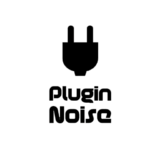Well, no need to lie, bass doesn’t always get the glory, but without it, your mix is basically a sandwich with no bottom slice. So, here are the best bass guitar plugins and Kontakt libraries that create the low-end flavor.
Whether you’re building cinematic suspense, crafting tight funk grooves, or anchoring a rock anthem, the bass guitar is what glues everything together. And if you’re not lucky enough to have a real bassist (and a great chain of amps, mics, and DI boxes), then a killer bass plugin or Kontakt library is your next best friend.
I’ve dug deep through tons of options over the years, from multi-articulated sampled instruments to deep round-robin Kontakt beasts and even synth-bass hybrids with character.
Some of these are hyper-realistic and sit in a mix like butter; others let you go full experimental, with amp sims, slap bends, and everything in between. And I’m not just talking about low notes, as I want expression, feel, and attitude.
In this roundup, we’re getting into the top bass guitar plugins and Kontakt libraries that actually deliver. Whether you’re scoring a film, producing a trap banger, or laying down retro funk lines, I’ve picked the ones that cover the most sonic ground with the least hassle.
Time to get low, let’s go!
1. Native Instruments Jam Bass
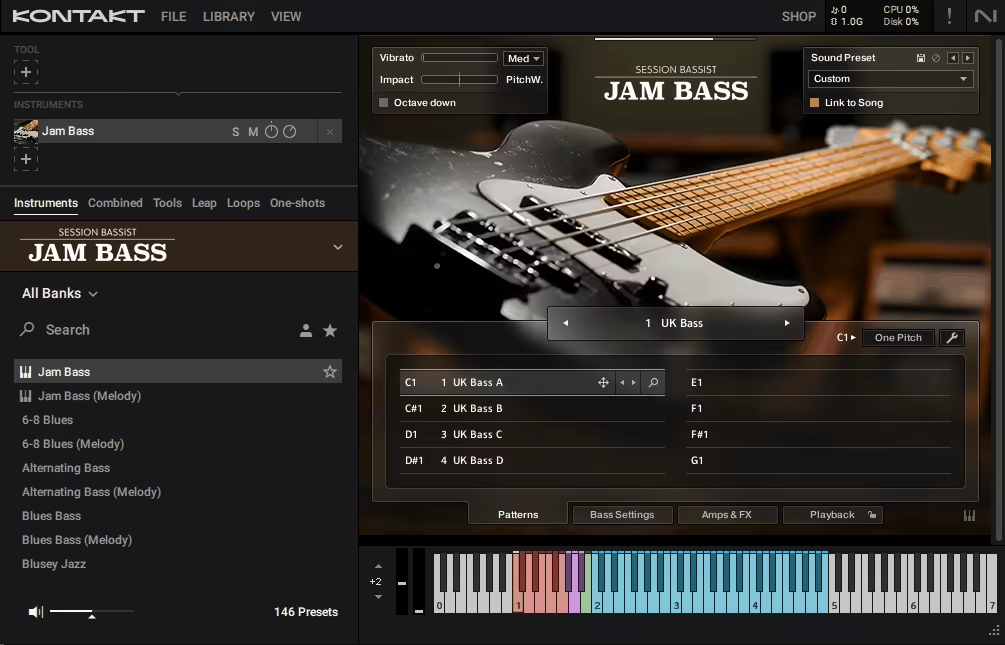
I’ll start with a versatile Jazz Bass virtual instrument with groove for days, welcome Session Basist Jam Bass.
What I love about Jam Bass is how instantly playable and vibe-rich it is. You don’t have to spend an hour tweaking samples just to get something moving. Just load it up, hit a pattern, and it grooves like a real player just walked in.
It’s basically the pocket king of the Session Bassist line, channeling the legendary character of a USA-made Jazz Bass with effortless musicality and a slick pattern engine to match.
The interface is classic Session Guitarist/Bassist style with two instruments, one for pattern-based playing and one for fully manual basslines. I found myself switching between them constantly.
The layout is intuitive: the phrase browser is deep but fast, and the articulation switching is beautifully integrated with NKS and Light Guide. Guitar Rig 7’s rig presets are just the icing, they make it super fun to go from clean and round to fuzzed-out and punchy in seconds.
- Dual-Pickup Tone Control
Blending the neck and bridge pickups gives you so much control over the vibe. I lean into the neck for warm, woody lines and then dial in the bridge for a bit of grit and clarity. You can go from dubby to disco without changing presets.
- Over 280 Real-Played Patterns
The included grooves are insanely usable. They’re not just stock riffs; they have feel. I’ve used the funk triplets and fingerstyle lines on real sessions, and they slotted right into the mix. You can even drag-and-drop the MIDI to tweak your own versions, which is huge.
- Guitar Rig 7 Integration
Here you get the clean DI and a ribbon mic signal, then run them through proper amp and cab chains in Guitar Rig.
I’ve built my own setups with compression, drive, and even stereo chorus, and it made the bass feel alive, not like a static sample.
- Expressive Playing Modes
It’s not just pattern-based, cause there’s a full instrument where you can perform your own lines with full articulation control. Slides, pops, dead notes, slaps… it’s all there and really responsive. I even assigned pitch bends and mod wheel for slides and expression.
What makes Jam Bass shine is how musical it feels out of the gate. I do wish there was a way to mark favorite patterns (seriously, NI, please add that), but otherwise it’s fast, expressive, and totally pro.
It’s become my go-to for funk, soul, pop, and even jazz-influenced cues where a real-feel bassline matters.
Session Bassist: Jam Bass comes in VST3, AU, AAX, and standalone formats for macOS and Windows users.
2. Solemn Tones Sanguine Bass
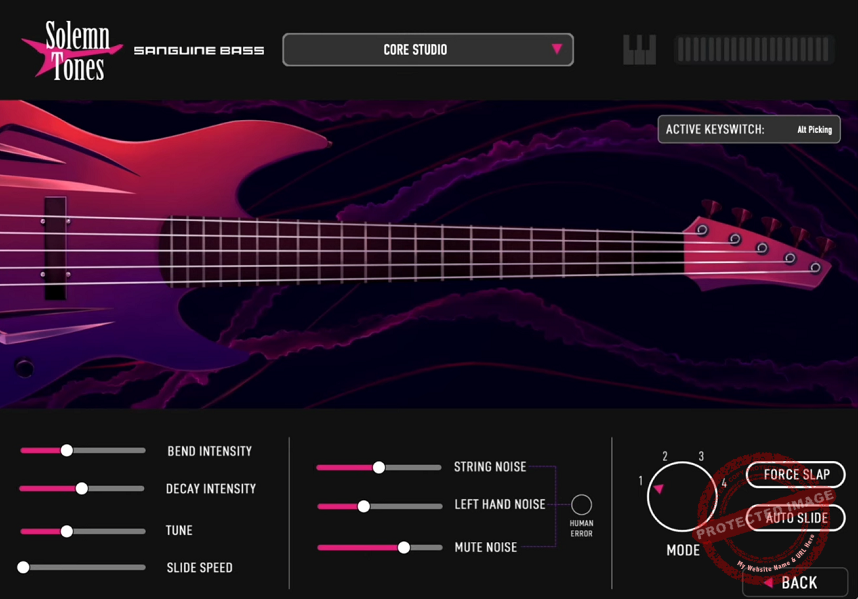
For those looking for a brutal and brainy virtual bass built for prog, djent, and modern metal, Sanguine Bass is the right address.
The first thing I can say about Sanguine Bass is how unapologetically focused it is. It’s not trying to be a do-it-all session player; it’s laser-targeted at heavy, technical music, and it nails that world.
This thing was sampled from an Aristides 050, which already has a reputation for super-tight low-end and singing sustain, and the results here are just as articulate and crushing as you’d expect. Honestly, if you’re writing modern metal, this might be the most plug-and-play MIDI bass you’ll find.
The interface is clean, snappy, and completely self-contained, no Kontakt required. That’s a huge win for workflow. Within a few clicks, I had fat low-tuned riffs coming out of my speakers that needed zero EQ to sit in the mix.
- 6 Mix-Ready Presets
From tight modern growl to warm and punchy low end, the baked-in tones sound killer straight out of the box.
The Darkglass B7K and Parallax chain give you options that just work. And if you’re a control freak (like me), the Clean DI is pristine and ready to reamp.
- Massive Tuning Range
It handles tunings all the way down to double drop C, which is perfect for modern prog and deathcore riffs. I used it in a track tuned to drop A# and it held tight without getting flubby or losing punch.
- Enforce Mode
I think this is a genius touch, as it replaces the sub info with a sine wave to keep your low-end tight and clean in the mix. For aggressive, kick-driven metal mixes, it’s a total lifesaver.
- 20 Articulations Including Slap
Slap in a metal bass? Yep, and it sounds surprisingly musical. You get dead notes, harmonics, open plucks, ghost notes, pitch bends, and so much more. I’ve never seen this level of expression outside of premium Kontakt libraries.
- Human Error Functionality
If things feel a little too perfect, you can dial in some subtle timing and velocity variance. It adds just enough human touch to make it feel natural without ruining the groove.
The only real catch here is that it’s a very niche tool. If you’re writing lo-fi pop or jazz ballads, this ain’t your guy. But for metal, djent, prog, hardcore, Sanguine Bass gets in, gets brutal, and gets out without ever needing a second plugin.
Sanguine Bass comes in VST3, AU, and AAX formats for macOS and Windows users.
3. Impact Soundworks Shreddage 3 Abyss
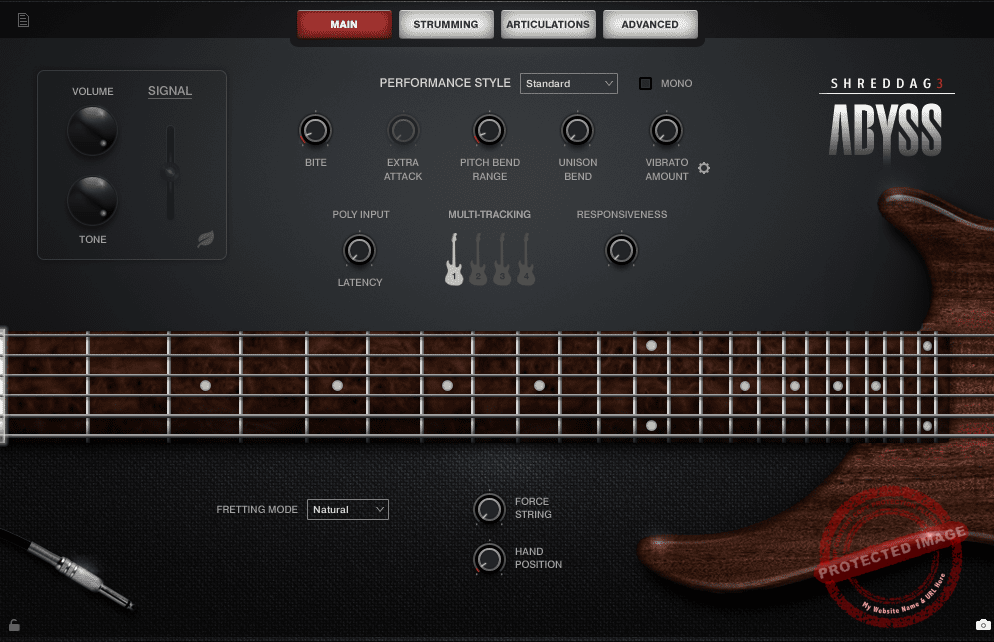
Heavy, deep, and unapologetically aggressive, that’s how I’d describe Abyss, the only bass guitar in Impact Soundworks’ Shreddage 3 line.
This isn’t your typical upright jazz bass or mellow fingerstyle virtual instrument. I’m talking about a monstrous custom 6-string Muckelroy bass, recorded drop-tuned to a floor-rattling low A, and sampled with obsessive attention to detail.
I tried a lot of virtual basses in heavy productions, and most fall short in realism or punch, but Abyss is the first one I’ve loaded up that sounds like it’s about to jump out of my speakers and punch me in the gut.
The interface is that slick Shreddage 3 layout I already know and love; tons of tweakability without getting lost in menus.
You get articulation mapping, velocity curve adjustments, and easy control over dynamics and tone. It’s pretty playable, whether you’re doing gnarly metal chugs, punchy funk plucks, or moody low-end ambience.
- Custom 6-String Bass Sampled in Drop A
Well, this thing is tuned to crush. The low range is beastly, and it still keeps clarity and definition all the way up the neck. Every fret, every dynamic, round-robins, it’s all here.
- Console FX Rack and 21 Tones
I love how quickly I can flip between clean DI, hi-gain madness, or ambient vibes using the included snapshots. No extra plugins needed. Console includes distortion, cab IRs, EQ, delay, and more, so you’re basically mixing inside the instrument.
- Total Articulation Control
Slides, hammer-ons, tapping, pops, harmonics, staccatos, are your weapons here. TACT 2.0 makes it easy to map all these to keyswitches, velocities, or MIDI CCs so I can play the way I want.
Abyss is a flagship-level instrument for metal, rock, prog, or even cinematic work that needs power in the low end. It does take up a chunk of disk space and RAM, but if you’re producing anything that demands realistic, playable electric bass with character and aggression, it’s worth every megabyte.
I’ve already dropped it into a few demos and didn’t feel the need to replace it with a live player. That says a lot!
Shreddage 3 Abyss runs in the free Kontakt Player 6.7 or higher and is fully compatible with NKS for macOS and Windows.
4. IK Multimedia MODO BASS 2
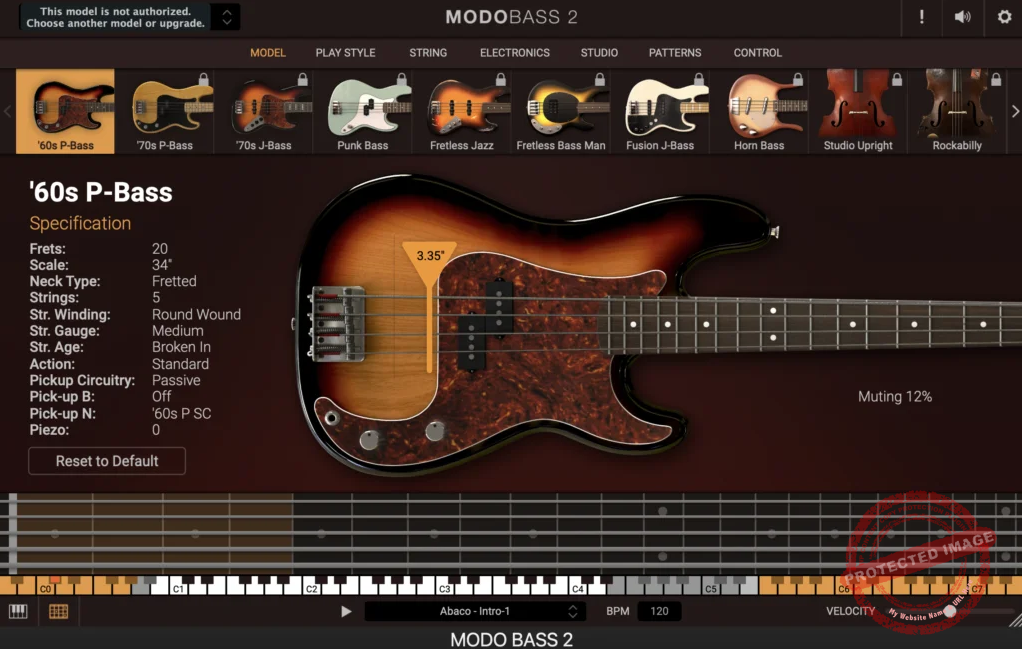
IK Multimedia didn’t just update their already-iconic physically modeled bass instrument; they gave it a full creative brain transplant with MODO BASS 2.
It doesn’t just sound like a bassist, it thinks like one. With 22 fully modeled instruments, new fretless and upright models, and deep control over performance style, string type, pickups, amps, FX and even playing position, MODO Bass 2 goes way beyond samples.
For me, the best part is that it’s not locked into one genre. For laying down fingerstyle soul grooves, slapping out some funk, or playing lo-fi upright jazz, it all feels shockingly believable.
The interface is split into 7 detailed views, and each one opens up a new rabbit hole of tone-shaping, articulation, and realism. To be honest, it takes a little time to learn, but it rewards you with absolute control.
- 22 Modeled Basses With Fretless & Upright Options
From classic J and P styles to rockabilly uprights and fretless fusion machines, this covers every bass tone you could possibly want. And they’re all physically modeled, not sampled, which means smaller file size and endless flexibility.
- Multi-Style Performance Engine
Choose between fingerstyle, pick, slap, and mute. Even choose where on the strings the virtual fingers play for added tone realism. I’ve never heard a plugin respond this dynamically to MIDI input before.
- Detailed Sound Customization
Mix and match strings, pickups (32 of them!), electronics, and playing techniques. You can even reposition mics on the amp and tweak string age, gauge, and muting. It’s like building a custom bass in real time.
- Genre-Based Pattern Browser
This is great for quick writing sessions or filling in a missing low end. You can browse by genre and key, audition groove patterns, and drop them straight into your DAW. Killer for sketching or finishing ideas fast.
- Stompbox FX and Amp Rigs Included
No need for extra plugins here, MODO Bass 2 has its own built-in stomp FX and amps, giving you polished, mix-ready tones without opening a second window. It’s not flashy, but it works.
While there’s the occasional lag if you overload it, especially on older machines, it’s a minor speed bump for what might be the deepest and most intuitive virtual bass instrument available today.
If you’re tired of dragging around lifeless MIDI basslines or feel like your low end is just phoning it in, MODO Bass 2 delivers a smart, stylish solution that adapts to whatever your track needs.
MODO BASS 2 is available as VST3, AU, and AAX plugins for macOS and Windows, no Kontakt required.
5. Native Instruments Icon Bass
![]()
Need a bassline that punches through the mix like a wrecking ball? Here is ICON BASS.
Icon Bass delivers that bright, biting tone of a 1989 USA-made classic, with the punchy presence only an active EQ and chunky bridge humbucker can bring.
Playing a snappy funk groove, a tight rock riff, or a clean pop hook, this library brings studio-grade realism with just the right amount of attitude.
It’s split into two instruments: one for easy pattern-based grooves, and another for custom melody writing. So whether I want to drag and drop session-style lines or perform my own riff with full expression, it’s got me covered.
The tone customization is pretty deep, too, with 4 amps, 10 cabs, 8 pedals, and enough studio FX to feel like I’m mixing a live session.
- Bright, Punchy, and Expressive
Recorded from a legendary active four-string with a fat alnico humbucker, ICON BASS has that tight midrange and zingy top end that makes it perfect for modern genres. I’ve used it on pop, funk, rock, you name it.
- Play Patterns or Go Full Melody Mode
The library includes both a groove-based instrument with 200+ riffs and a solo instrument for custom parts. I love using one to build rhythm and the other to add fills or intros.
- Deep Tone Shaping with Amp & FX Chains
From clean DI tones to aggressive distortion, you can shape this bass in infinite ways. It includes 4 amps, 10 cabs, 8 stompboxes, and 11 pro studio effects (reverbs, delays, EQs, compressors, and more).
- Built-In Session Realism
Automatic hammer-ons, pull-offs, fret noise, dead notes, and realistic transitions give it the polish of a real player. It also handles slides, slaps, pops, mutes; basically, it’s your favorite bassist in a plugin.
- Komplete Kontrol & NKS-Ready
The Light Guide makes performance super intuitive with clear articulation switching and expressive technique triggers. I found this made a huge difference when sketching fast.
Whether you’re sketching demos or delivering a finished track, ICON BASS makes writing basslines easy, authentic, and inspiring. It’s one of the most mix-ready, performance-friendly bass libraries in the Native Instruments catalog.
Icon Bass runs in Kontakt 7.1.8 or the free Kontakt Player. NKS-compatible.
6. Ample Bass TR6
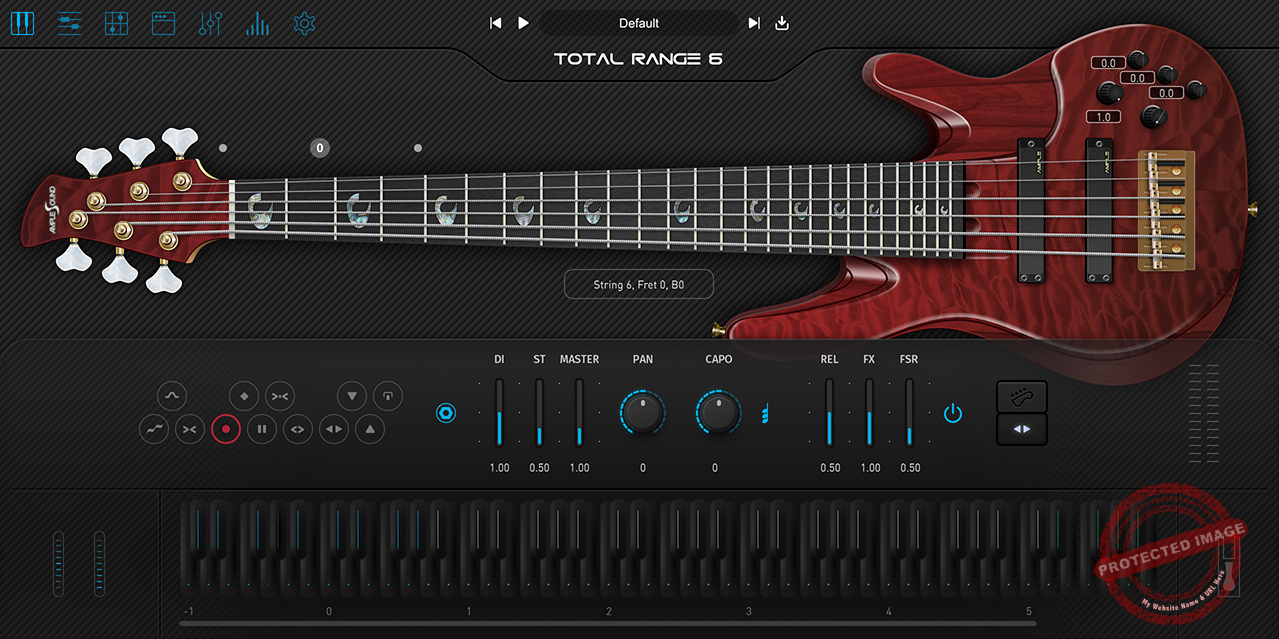
What makes Ample Bass TR6 truly stand out for me is how it captures the signature sound and feel of John Patitucci’s Yamaha TRBJP2 bass with such nuance and realism.
I love how Ample Bass TR6 goes beyond just samples, delivering a deeply expressive experience with its 14 articulations and that slick Riffer 4 MIDI engine. I really enjoyed that it responds naturally to playing dynamics and string behavior, making bass lines come alive even if you’re programming rather than recording live.
Navigating between the different tabs from choosing the bass model to tweaking amps, cabs, and effects feels intuitive and smooth. The built-in amp and effects section means I don’t have to juggle multiple plugins to get a polished bass tone, which is a huge time saver.
It’s a joy to work with, especially when I’m crafting detailed bass parts that need to feel both authentic and polished.
- Realistic 14 Articulations and Multi-Sampling
This is where TR6 shines big time. The variety of articulations from fingerstyle grooves to slides and hammer-ons lets me program bass lines with real expression, not robotic or stiff sounds.
I often use the polyphonic legato and slide smoother to create smooth transitions that give my bass parts a natural flow, perfect for jazz and fusion tracks where nuance matters.
- Riffer 4 MIDI Engine with Intuitive Control
I think the onboard Riffer 4 is a total game-changer. I’ve found it incredibly handy for quickly sketching bass riffs or adding human-like variations without having to manually edit every note.
The piano roll and tab views make it super flexible whether I’m a notation fan or prefer visual MIDI editing. It’s helped me nail tricky rhythms and phrasing much faster.
- Built-In Amp and FX Suite
I love that TR6 includes classic amps, cabinets, and a solid effects rack with EQ, compression, delay, and convolution reverb. Being able to sculpt my tone inside the plugin means I stay focused and creative without pulling in external plugins.
All in all, Ample Bass TR6 is especially ideal for jazz, fusion, and any style that demands both subtlety and versatility in bass performance. If you want a bass plugin that feels alive and keeps your workflow tight, this one’s definitely worth checking out.
Ample Bass TR6 comes in VST2, VST3, AU, AAX, and standalone formats for macOS and Windows users.
7. Native Instruments Prime Bass

Where Prime bass shines is its success in nailing the classic Fender Precision bass vibe from the ’70s; punchy, clear, and rich enough to cut through even the busiest mixes without losing its warmth.
The interface feels super familiar if you’ve used any other Session Guitarist instruments, which means zero learning curve and more time making music.
The Song Presets window is nicely laid out, and browsing through over 350 performance patterns grouped in 81 song presets feels effortless.
I really appreciate the 4-tab setup of Prime Bass, letting you jump between Patterns, Bass Settings, Amps & FX, and Playback controls without digging through menus. Plus, real-time controls and that handy Octave Down switch make tweaking grooves on the fly a breeze.
- Vintage Fender Precision Bass Sound
Prime Bass was recorded through a vintage Universal Audio M-610 preamp and features mic placements above the strings for extra presence.
The result? A tone that’s thick and punchy with plenty of midrange to slice through mixes, making it perfect for styles from rock and pop to funk and country. I loved how well the pickup and amp simulations translate the vibe of an authentic electric bass.
- Massive Library of Performance Patterns
With over 350 patterns and round-robin variations across three octaves, this library offers tons of options. I especially dig the ability to switch patterns with keyswitches or drag and drop MIDI into my DAW for further editing.
The variety lets me cover everything from laid-back funk grooves to driving rock lines. It’s like having a pro session bassist ready to jam anytime I want.
- Powerful Amp & FX Section
The Amps & FX tab includes up to 7 slots for effect pedals, amps, cabinets, and signal chains.
I usually pick a gritty tube amp preset like Modern Tube to add warmth and edge while keeping clarity. The flexibility here means I rarely need to open extra plugins to get a polished bass tone, which speeds up my workflow a lot.
It’s great if you want authentic, ready-to-go grooves or detailed, tweakable bass parts without the hassle of programming everything from scratch.
While I’d love to see some jazz patterns in future updates (and maybe a fretless bass library?), Prime Bass already feels like the next best thing to hiring a session pro. If you want tight, realistic bass performances that sit perfectly in your mix, this one’s a solid pick.
Session Bassist: Prime Bass comes in Kontakt Player and full Kontakt formats for macOS and Windows users.
8. Toontrack EZbass
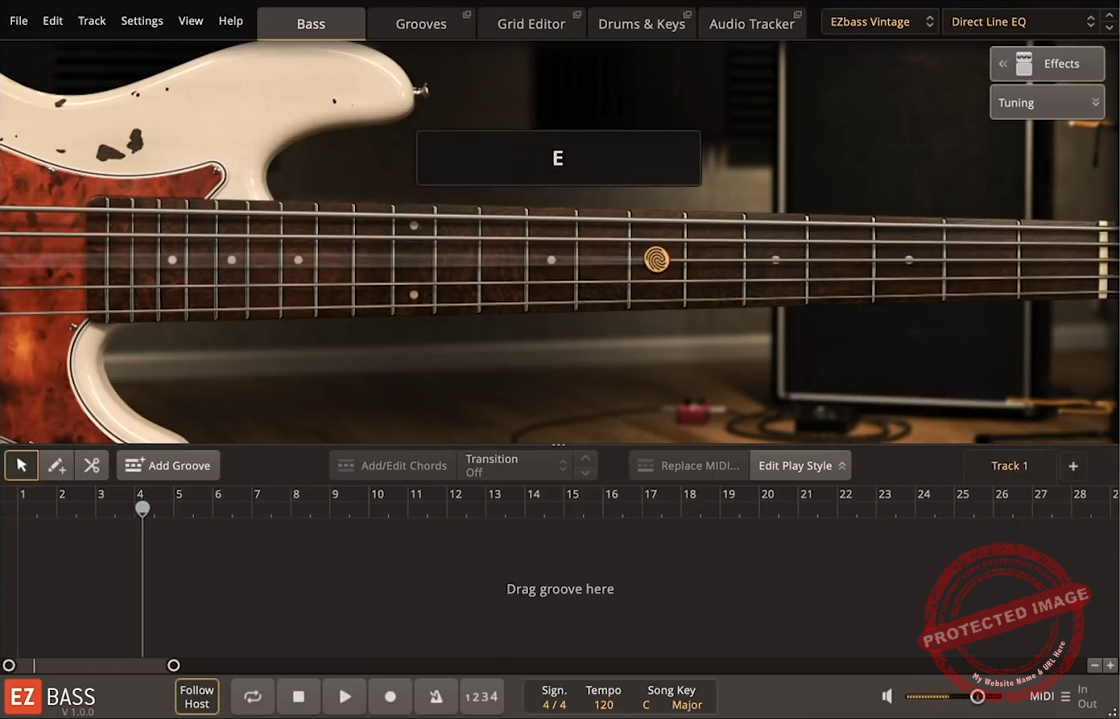
EZbass combines pristine, realistic bass samples with a powerful virtual player that feels like having a pro bassist right inside my DAW.
The slick, modern interface borrows a lot from Superior Drummer 3, making it instantly familiar if you’ve used their other EZ titles, but it’s tailored perfectly for bass players and producers.
The UI is clean, intuitive, and flexible, and I especially dig how I can float the Grid Editor window to keep tabs on my MIDI editing while still browsing grooves or managing the Song Track.
The EZbass workflow is smooth, with everything from browsing hundreds of MIDI grooves to fine-tuning articulations and tone controls feeling natural and fun rather than a chore.
- High-Quality Vintage & Modern Bass Samples
EZbass features two core libraries: Vintage and Modern, both with finger and pick playing styles. The vintage bass has a warm, smooth tone, while the modern bass delivers extra low-end thump and bite.
I love how the DI presets sound clean and solid, letting me add my favorite amp sims or stick to EZbass’s built-in effects. The subtle fretless vibe in the “Fretless Feeling” preset is a nice bonus for adding some flavor without a dedicated fretless library.
- Massive Groove Library with Smart Browsing
With over 1,000 MIDI grooves across a wide range of styles and feels, finding the perfect bassline is a breeze. The Groove browser even shows mini graphics of each pattern’s rhythm and pitch content, such a handy visual cue!
Plus, features like Tap2Find let me tap a rhythm or drop a drum MIDI clip to instantly find matching bass grooves, speeding up my workflow big time.
- Flexible Effects and Output Routing
EZbass includes macro controls to tweak each preset’s sound, like adding sub-bass for more low-end weight or dialing in distortion and modulation.
I also appreciate the multiple outputs, which let me send DI, amped, and sub-bass signals to separate DAW channels for custom mixing and processing.
In the end, Toontrack EZbass feels like the next-level virtual bassist I’ve been waiting for. It nails that authentic bass feel with enough flexibility to fit any style or production need.
If you ask me, this one’s gonna be a staple in any producer’s toolkit who needs top-notch bass without the hassle of recording a live player.
Toontrack EZbass comes in Kontakt Player and full Kontakt formats for macOS and Windows users.
9. Native Instruments Scarbee Rickenbacker Bass
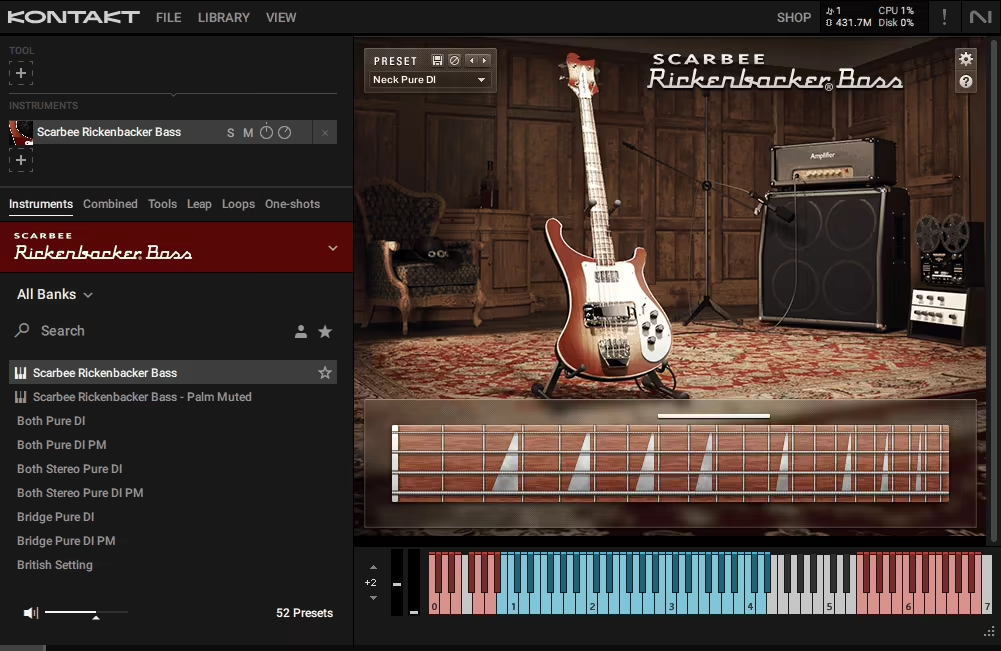
I’ve always been a fan of the iconic “Ricky” bass tone, so when I got to try Scarbee Rickenbacker Bass, I was eager to see if it really nails that unique vibe.
This virtual instrument captures the distinctive, gritty, almost guitar-like sound that Rickenbackers are famous for, something you don’t often find in virtual bass instruments. It feels like having that classic rock and prog bass sound right under my fingers, whether I want the punchy, picked attack or the smooth palm-muted vibe.
I appreciate the thoughtful layout, which includes controls for pickups, tone shaping, and a variety of built-in effects like amp simulation, tape saturation, and SSL-modeled compression and EQ.
The GUI of Scarbee Rickenbacker Bass is pretty intuitive, and I found the MIDI Learn feature super handy for mapping controls to my MIDI gear, keeping everything responsive and musical. Plus, switching between the palm-muted and undamped instruments is seamless, letting me blend styles in the same project with ease.
- Pick and Palm Muted Instruments
Scarbee offers two separate Kontakt instruments: one for the classic undamped “Ricky” growl and one for palm-muted tones.
I dig how the palm-muted version captures that controlled, percussive sound perfect for country or funk, while the undamped instrument delivers the rich sustain and gutsy power that cuts through dense mixes.
- Advanced Articulation Controls
The plugin’s scripting intelligently handles string selection and pick directions but also lets you override those for detailed expression.
I especially enjoy the flexible trills and buzz trills that you can play at your own speed and length, plus the forced hammer-on/off keyswitch that adds realistic nuances. These little details make playing or programming bass lines feel super authentic.
- Built-in Effects & Tone Shaping
Scarbee Rickenbacker Bass comes with a solid suite of onboard effects, including amp sims, cabinets, tape saturation, and a streamlined SSL compressor and EQ.
I found these controls great for sculpting the tone without leaving the plugin, and the ‘Rick-O-Sound’ pickup panning lets me send neck and bridge pickups to separate channels for creative mixing tricks.
Overall, Scarbee Rickenbacker Bass is a joy to play and sounds fantastic in a mix. It’s got that classic “Ricky” personality but with the flexibility and polish you want in a modern virtual instrument.
If you’re into rock, pop, or prog and want an authentic bass tone that commands attention without hogging the mix, this one’s a no-brainer.
Scarbee Rickenbacker Bass comes in Kontakt format for macOS and Windows users.
10. UJAM – Virtual Bassist 2 ROYAL
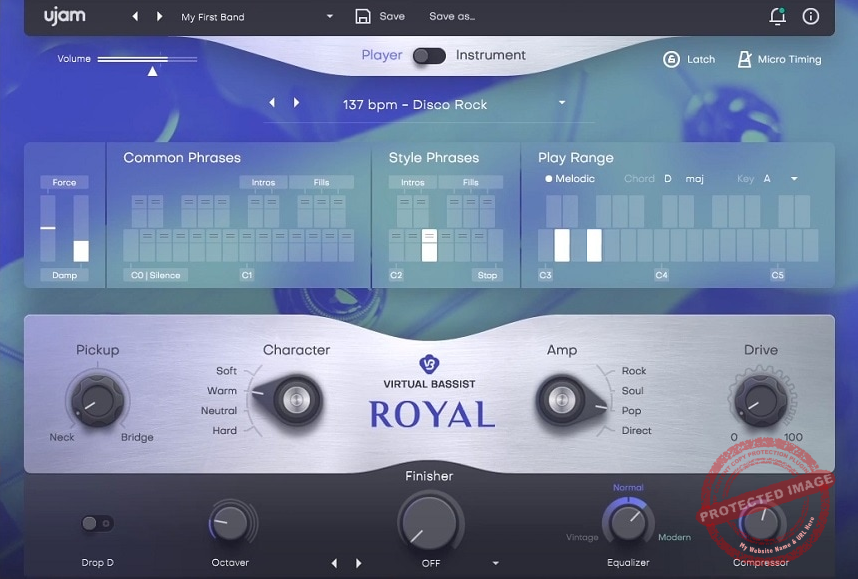
I’ve always appreciated a bass plugin that can effortlessly slide into any track without a fuss, and UJAM Virtual Bassist 2 Royal does exactly that.
What I really enjoy is how Virtual Bassist 2 ROYAL delivers that smooth, rounded fingerstyle electric bass tone that fits perfectly in pop, indie, rock, and singer-songwriter material alike. Royal feels like a session pro you can call on anytime; solid, musical, and super easy to work with.
The interface comes with a clean design and the “fewer controls, more control” philosophy. I love how quickly you can jump into one of the 60 styles and 1380 phrases, then tweak the sound using simple but powerful tone shaping and effects.
- Extensive Style & Phrase Library
With 60 styles and 1380 phrases, Royal covers a ton of ground from ballads and funk to hip-hop, reggae, and classic rock.
I’ve found the phrase variety fantastic for quickly laying down solid bass foundations, especially with the handy MIDI drag-and-drop feature. The styles feel natural, so I rarely need to tweak patterns to fit my groove.
- Intelligent Player Mode
Royal’s Player Mode automatically adjusts the bass performance to your chords and even offers melodic variations outside the chord for a more interesting sound. This smart articulation modelling means I can focus more on songwriting and less on tedious programming.
- Simple Yet Powerful Sound Shaping
Dialing in the tone is a breeze with a selection of amps, effects, EQ, and dynamics controls. I particularly like the Finisher multi-effect modes that add flair without overwhelming me with complicated settings.
All in all, UJAM Virtual Bassist 2 Royal is a versatile, musical virtual bassist that makes bass tracking fast and fun. It’s ideal for songwriters, producers, and media composers who want professional-sounding bass parts without wrestling complicated interfaces or endless editing.
UJAM Virtual Bassist: Royal comes in VST and AU formats for macOS and Windows users.
Extra:
1. SP Jambass (Free)
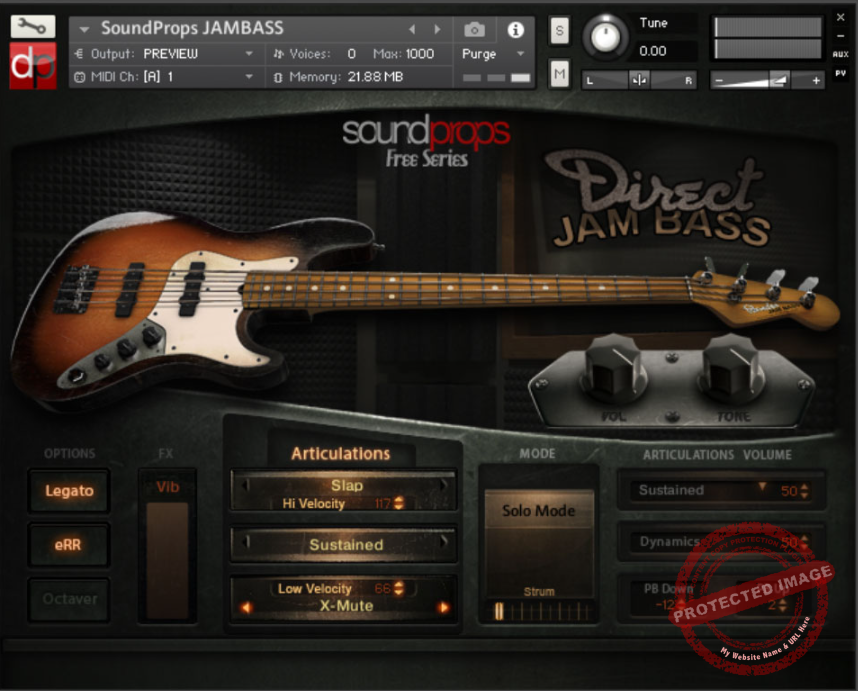
For those who don’t want to spend some bucks on a bass virtual instrument, SP Jambass is a pretty solid freebie option.
JAMBASS captures the classic vibe of one of the most iconic electric basses first made in 1960.
- Two Single-Coil Pickups
Featuring both single-coil pickups active simultaneously, along with simple volume and tone controls, it delivers that bright, twangy country sound while covering a wide tonal palette.
- Great for Clean Sounds
This bass fits effortlessly into genres like country, pop, rock, blues, funk, and jazz, making it a versatile choice for many musical styles.
When I tried it, I really liked it for reggae sounds as it’s got these great funky and clean articulations.
2. Shreddage 3 Precision FREE
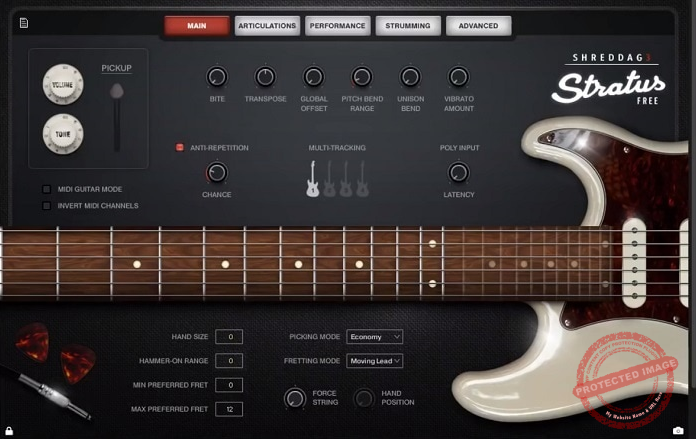
The final pick is another freebie, Shreddage 3 Precision, which really stands out not only with its price tag but its massive sound.
I’m not talking some dinky “lite” version with two notes and a dream, cause this baby gives you high-quality fingerstyle bass, release samples, popping, and all the articulation mapping flexibility of a full-fledged pro instrument.
Honestly, I was floored the first time I loaded Shreddage 3 Precision FREE up and realized how much tone-shaping and performance control was available with a big fat $0 price tag.
The interface is slick, clean, and easy to navigate, even if you’re not deep into Kontakt libraries. I loved how organized everything was, especially the Console FX rack.
It doesn’t feel like a stripped-down version of something else; it feels like a real instrument that just happens to be free. Mapping articulations, tweaking tone snapshots, and setting up the voicing engine were way easier than I expected. Even with limited keyswitch ranges, it felt playable and intuitive.
- TACT 2.0 Articulation Mapping
This is where it shines for me. You get the same powerful articulation engine as the full version, letting you assign and customize how each articulation triggers.
That means you’re not stuck with someone else’s layout; you can build your own ideal bass workflow. It’s a game-changer for expressiveness, especially when doing mock-ups for funk or fusion lines.
- Console FX Rack with 30+ Modules
I absolutely love the Console, as it’s like having a mini guitar rig builder baked right into the instrument. I’ve used the cab IRs and analog-style EQs to go from a warm Motown groove to a punchy indie rock tone in seconds. The built-in tone snapshots are great starting points too, especially when you’re sketching out ideas fast.
- Realistic Fretting and Voicing Engine
Despite only having two octaves, this thing sounds real. I’ve tried it with layered pop productions and jazzy solo phrases, and the voicing engine gets the string positions and transitions super convincingly.
You also get round robins and dynamic layers, which means every note feels alive, even with repeated hits.
If there’s a downside, it’s the limited range (B0 to B2) and fewer articulations than the full version, but honestly, that’s expected with a freebie. You still get more than enough for core bass duties, and it responds beautifully to velocity and mod/pitch controls.
For anything from pop to jazz, funk to lo-fi, this truly can be a go-to bass. It’s surprisingly full-bodied, sits well in a mix, and doesn’t hog CPU. And with full Kontakt Player support, it’s even easier to integrate into any workflow.
Shreddage 3 Precision Free comes in Kontakt Player format for macOS and Windows users.
Last Words
Whether you’re chasing a snarling rock tone, a mellow jazz thump, or just need a pocket-tight session player that won’t complain about coffee breaks, this list has you covered. I’ve had a blast testing each of these bass beasts, and honestly, I could drop any of them into a track and feel confident they’ll hold down the low end like pros.
Some are dead simple and vibe-ready right out of the box. Others are tweakable monsters with endless tone-shaping options. What I love is that there’s something here for every style and budget, whether you want the raw realism of a multi-sampled Kontakt library or a fast, virtual bassist with AI-level groove.
If you’re anything like me, you’ll probably end up with more than one of these in your toolkit. Trust me, having a few different flavors of bass makes all the difference when you’re jumping from indie folk to EDM to cinematic scoring. Go ahead, pick your poison or better yet, stack ’em up and make some noise, and happy mixing!

Berk Öztuna, a musician from Istanbul, is skilled in handpan, percussion, and guitar, performing and recording his own compositions globally. With expertise in music production and audio technology, he integrates virtual instruments and sound design tools seamlessly into his work. He also writes insightful articles on music production and gear for platforms like Plugin Noise and shares his music on Spotify and Instagram.
DONATE: Love our content? Help us keep Plugin Noise alive in the age of AI — Your donation fuels better content for music creators like you! You can donate here: pluginoise@gmail.com (Every amount counts.)
